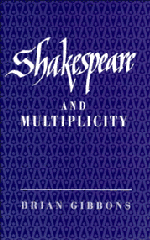Book contents
- Frontmatter
- Contents
- Acknowledgements
- 1 Introduction
- 2 Fabled Cymbeline
- 3 A speechless dialect: interpreting the human body in Shakespeare's plays
- 4 Shakespeare's ‘road of excess’: Titus Andronicus, The Taming of the Shrew, King Lear
- 5 Always topical: Measure for Measure
- 6 Amorous fictions in As You Like It
- 7 Unstable Proteus: Marlowe and Antony and Cleopatra
- 8 Multiplicity
- Notes
- Bibliography
- Index
3 - A speechless dialect: interpreting the human body in Shakespeare's plays
Published online by Cambridge University Press: 30 September 2009
- Frontmatter
- Contents
- Acknowledgements
- 1 Introduction
- 2 Fabled Cymbeline
- 3 A speechless dialect: interpreting the human body in Shakespeare's plays
- 4 Shakespeare's ‘road of excess’: Titus Andronicus, The Taming of the Shrew, King Lear
- 5 Always topical: Measure for Measure
- 6 Amorous fictions in As You Like It
- 7 Unstable Proteus: Marlowe and Antony and Cleopatra
- 8 Multiplicity
- Notes
- Bibliography
- Index
Summary
A silent and inert body may be alive, it may indeed be soundly sleeping, though it may also be unconscious, dreaming or dying. It may resemble in its beauty sculpted stone or it may be distorted and broken. A silent and inert body may be a dead thing, a corpse, the processes of corruption already at work within it, its human identity disappearing.
The silent and inert body is a sign both of renewal and extinction: it is as powerful as it is ambivalent, a focal image of Shakespeare's dramatic imagination. He returned to it repeatedly in many different forms, though it is particularly intriguing to notice that it is centrally significant in his early non-dramatic work – the narrative poem The Rape of Lucrece.
Drama is a performance art in which the set codes and patterns are expressed with the direct immediacy of the actors' live bodies: the instinctive life of the flesh becomes part of a premeditated symbolic language, yet that premeditated code is at the same time risked in the existential circumstances of live performance. Paradoxically, it is when the body is silent and inert in a play that its contrasting aspects – of corporeal presence, sign for a person in the fiction, and intermittent symbolic–sculptural image – may be most apparent, as in Romeo and Juliet when Juliet lies in the Capulet tomb, near Tybalt's body in its bloody shroud, or – a less obvious case – in King Lear, when the blind Gloucester lies ominously still, having leapt from an imaginary cliff, and his apprehensive son Edgar kneels to examine him.
- Type
- Chapter
- Information
- Shakespeare and Multiplicity , pp. 48 - 78Publisher: Cambridge University PressPrint publication year: 1993



